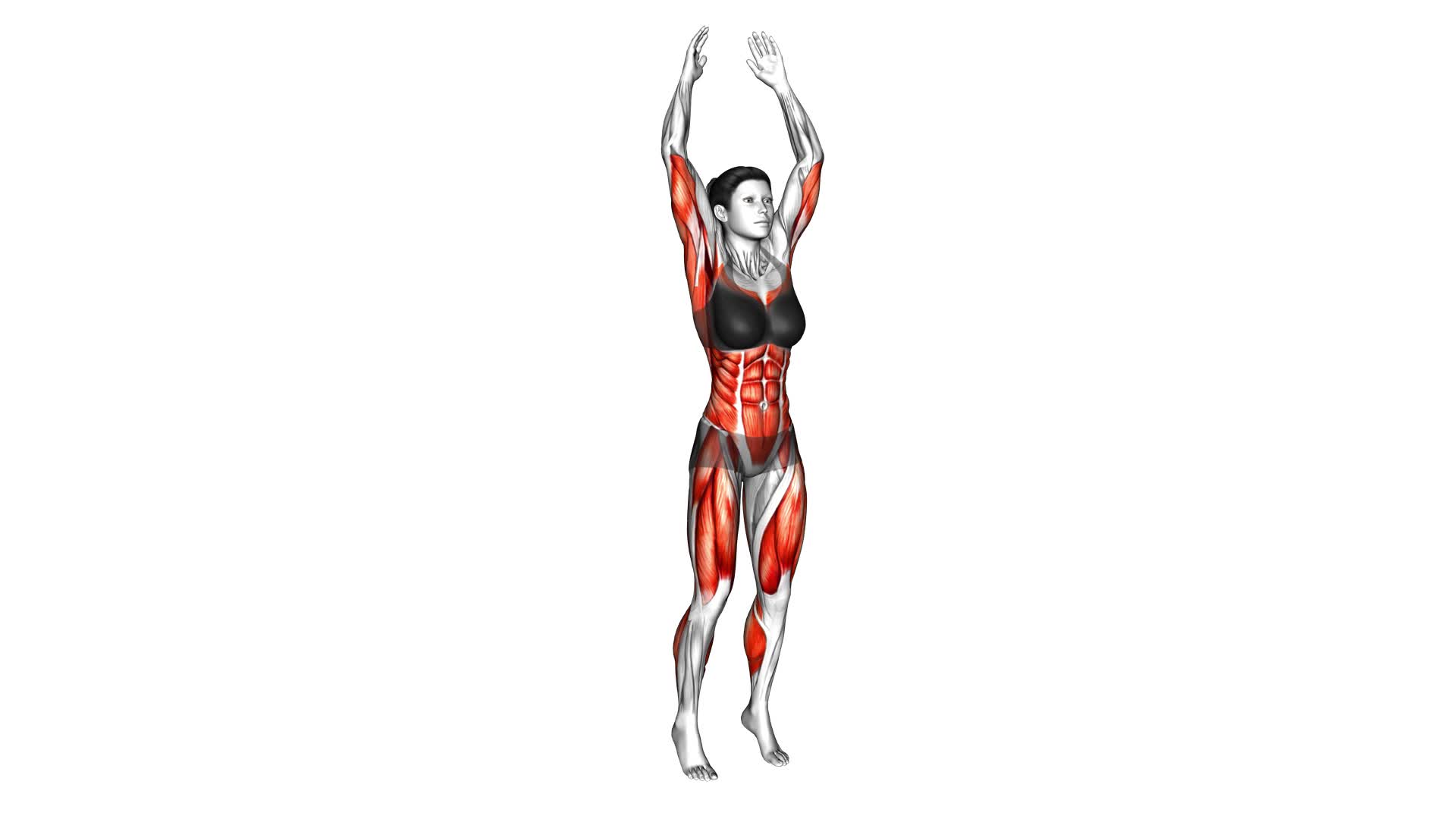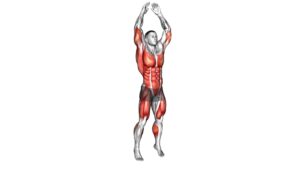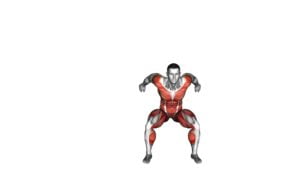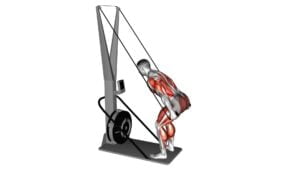Ski Runners (female) – Video Exercise Guide & Tips

Are you ready to take your skiing skills to the next level? Look no further than our video exercise guide and tips for female ski runners.
Watch This Exercise Video
In this article, we will show you effective warm-up exercises, core strengthening workouts, and lower and upper body exercises to enhance your performance on the slopes.
We'll also share balance and stability drills and endurance training techniques to help you build stamina and improve your overall skiing abilities.
Get ready to conquer the mountains like never before!
Key Takeaways
- Dynamic stretching and warm-up exercises are important for injury prevention and improved performance.
- Core strengthening exercises like planks and stability ball exercises help maintain balance and stability while skiing.
- Lower body exercises such as squats and lunges target leg strength and power.
- Upper body exercises like push-ups and shoulder press work on strengthening the chest, shoulders, and arms.
Warm-Up Exercises
Start your ski workout by performing these warm-up exercises. Dynamic stretching is an essential part of preparing your body for the slopes. Not only does it increase your flexibility and range of motion, but it also helps to prevent injuries. By incorporating dynamic stretches into your warm-up routine, you're actively engaging your muscles and joints, getting them ready for the physical demands of skiing.
There are several benefits of warm-up exercises before hitting the slopes. Firstly, they increase blood flow to your muscles, which helps to improve their performance. This means that you'll be able to ski with more power and control. Secondly, warm-up exercises also help to activate your nervous system, which enhances your coordination and balance on the slopes. Lastly, by preparing your body through warm-up exercises, you'll be able to prevent muscle strains, sprains, and other skiing-related injuries.
Some dynamic stretching exercises you can incorporate into your warm-up routine include leg swings, arm circles, high knees, and lunges. These exercises target the muscles and joints that are used during skiing, such as the quadriceps, hamstrings, and glutes. Remember to perform each stretch in a controlled and deliberate manner, without bouncing or jerking motions. Take your time and listen to your body, gradually increasing the intensity of the stretches as your muscles warm up.
Core Strengthening Workouts
To further enhance your ski workout routine, regularly incorporate core strengthening workouts into your training regimen. A strong core is essential for maintaining balance and stability while skiing, as it helps you stay in control and execute precise movements on the slopes. Here are three effective exercises that will target and strengthen your core muscles:
- Plank Variations: Planks are a fantastic exercise for strengthening your entire core. Start with a basic plank by getting into a push-up position and holding it for as long as you can. As you progress, try different variations such as side planks and plank jacks to challenge your core from different angles and engage more muscles.
- Stability Ball Exercises: Using a stability ball adds an element of instability, forcing your core muscles to work harder to maintain balance. Try exercises like stability ball crunches, leg lifts, and Russian twists to engage your abs, obliques, and lower back. These exercises won't only strengthen your core but also improve your overall balance and coordination.
- Mountain Climbers: Mountain climbers are a dynamic exercise that targets your core while also incorporating cardiovascular elements. Begin in a plank position and alternate bringing your knees towards your chest in a running motion. This exercise engages your abs, obliques, and hip flexors, helping you develop a strong and stable core.
Lower Body Exercises
Are you ready to take your lower body workout to the next level? Let's talk about squats versus lunges and how plyometrics can help you build power.
Squats and lunges are both great exercises for targeting your legs, but they work different muscle groups. Squats are fantastic for overall leg strength, while lunges target your glutes and hamstrings.
And if you really want to amp up your lower body power, incorporating plyometrics into your routine can help you explode off the ground and improve your athletic performance.
Squats Vs Lunges
Get the most out of your lower body workout by comparing and choosing between squats and lunges. Both exercises target multiple muscles in your lower body and can help you build strength, improve balance, and increase flexibility.
Here are three key factors to consider when deciding between squats and lunges:
- Muscle Activation: Squats primarily target your quadriceps, hamstrings, and glutes, while lunges engage these muscles along with your calves and core. If you want to focus on building strong quadriceps and glutes, squats may be the better option. However, if you're looking for a more comprehensive lower body workout that also works your calves and core, lunges are a great choice.
- Range of Motion: Squats involve a more vertical movement pattern, focusing on knee and hip flexion. Lunges, on the other hand, require a greater range of motion as you step forward or backward, activating your muscles in different planes. If you want to improve your mobility and stability, lunges offer a broader range of movement.
- Joint Stress: Squats put more stress on your knees and lower back, especially if you have pre-existing issues. Lunges, on the other hand, distribute the load more evenly across your legs and can be a safer option for those with knee or lower back problems. It's important to listen to your body and choose the exercise that feels comfortable and pain-free for you.
Plyometrics for Power
When choosing between squats and lunges, incorporating plyometrics into your lower body routine can further enhance power and explosiveness in your movements. Plyometrics for speed involves incorporating explosive jumping techniques into your workout. These exercises focus on developing fast-twitch muscle fibers, which are responsible for generating quick, powerful movements.
By adding plyometrics to your routine, you can improve your overall speed and agility, making you more efficient in your sport or activity. Some effective plyometric exercises for lower body power include box jumps, squat jumps, and lunge jumps. These exercises require you to generate maximum force in a short amount of time, improving your ability to explode off the ground.
Now, let's move on to the next section and explore some upper body exercises to complete your full-body workout.
Upper Body Exercises
Strengthen your upper body with these effective ski runner exercises. Incorporating shoulder workouts and arm exercises into your fitness routine won't only help you improve your skiing performance but also enhance your overall upper body strength.
Here are three key exercises to target your shoulders and arms:
- Push-ups: This classic exercise targets your chest, shoulders, and triceps. Start in a plank position with your hands slightly wider than shoulder-width apart. Lower your body until your chest grazes the floor, then push back up to the starting position. Aim for three sets of 10-15 reps.
- Shoulder press: Grab a pair of dumbbells or resistance bands and stand with your feet hip-width apart. Start with the weights at shoulder level, then press them overhead until your arms are fully extended. Lower the weights back down to shoulder level. Perform three sets of 8-12 reps.
- Bicep curls: Stand with a dumbbell in each hand, palms facing forward. Keep your elbows close to your sides and curl the weights up towards your shoulders, squeezing your biceps at the top. Lower the weights back down with control. Complete three sets of 10-12 reps.
Balance and Stability Drills
Improve your balance and stability with these essential drills to enhance your skiing performance. Balance training and stability exercises are crucial for maintaining control and preventing injuries on the slopes. These drills not only help you stay upright on your skis but also allow you to navigate uneven terrain with ease.
One effective balance training exercise is the single-leg balance. Stand on one leg with your knee slightly bent and try to maintain your balance for as long as possible. This exercise strengthens the muscles in your ankles and improves your overall stability.
Another useful exercise is the stability ball plank. Get into a plank position with your forearms resting on a stability ball. Engage your core and hold this position for 30 seconds to one minute. This exercise targets your core muscles, which are vital for maintaining balance and stability while skiing.
Additionally, practicing yoga can greatly enhance your balance and stability. Poses like Tree Pose and Warrior III challenge your balance and strengthen your leg muscles. Incorporating yoga into your training routine won't only improve your skiing performance but also increase your overall flexibility and body awareness.
Endurance Training Techniques
Are you looking to improve your endurance and stamina for skiing?
One effective training technique is HIIT, or high-intensity interval training, which involves short bursts of intense exercise followed by a period of rest. Incorporating HIIT into your workouts can help improve your cardiovascular fitness and increase your endurance on the slopes.
Additionally, long distance running can also be beneficial for building endurance and stamina. By gradually increasing your mileage and focusing on maintaining a steady pace, you can enhance your overall endurance and prepare yourself for long days on the mountain.
HIIT for Endurance
Boost your stamina and improve your endurance with HIIT workouts. High-Intensity Interval Training (HIIT) is a great way to increase your cardiovascular fitness while burning calories. Here's why HIIT is effective for endurance training:
- HIIT for weight loss: HIIT workouts are known for their ability to burn a high number of calories in a short amount of time. This can help you shed excess weight, which in turn can improve your endurance by reducing the strain on your joints and muscles.
- HIIT vs steady state cardio: While steady state cardio is beneficial for building endurance, HIIT takes it to the next level. The intense bursts of activity followed by short recovery periods in HIIT workouts push your cardiovascular system to adapt and become more efficient, ultimately improving your endurance.
- Variety and challenge: HIIT workouts offer a wide range of exercises and formats, keeping your training sessions interesting and challenging. This variety prevents boredom and allows you to continuously push your limits, leading to improved endurance performance.
Long Distance Running
To enhance your endurance and prepare yourself for the demands of long-distance running, incorporate long distance running techniques into your training routine.
Long distance running is a key component of marathon training and requires a combination of physical and mental stamina.
Endurance nutrition plays a crucial role in sustaining energy levels during long runs. Make sure to fuel your body with a balanced diet that includes carbohydrates, proteins, and healthy fats.
Hydration is also vital, so drink plenty of water before, during, and after your runs.
Gradually increase your mileage each week to build up your endurance.
Incorporate interval training, tempo runs, and long slow distance (LSD) runs into your routine to improve your endurance and pace.
Remember to listen to your body and give yourself enough rest and recovery time.
Stay committed, stay motivated, and you'll be well on your way to conquering your marathon goals.
Frequently Asked Questions
How Long Should a Warm-Up Exercise Session Be Before Starting Ski Runners?
Before starting ski runners, it's important to warm up properly. The warm-up duration should be long enough to prepare your body for the activity ahead. A good rule of thumb is to spend at least 10-15 minutes warming up. This helps increase blood flow to your muscles, improves flexibility, and reduces the risk of injury.
Are There Any Specific Core Strengthening Workouts That Are More Beneficial for Ski Runners?
When it comes to core strengthening workouts, there are specific exercises that can be more beneficial for ski runners. These exercises target the muscles in your core, helping to improve stability and balance while skiing.
By incorporating specific core exercises into your routine, you can enhance your performance on the slopes and reduce the risk of injury.
Can Lower Body Exercises for Ski Runners Be Modified for Individuals With Knee or Hip Injuries?
You're wondering if lower body exercises for ski runners can be modified for those with knee or hip injuries.
The good news is, there are modified exercises and rehabilitation options available to help you stay active and strengthen your lower body without putting too much strain on your injured joints.
Are There Any Upper Body Exercises That Can Help Improve Balance and Stability for Ski Runners?
To improve your balance and stability as a ski runner, incorporating upper body exercises into your routine can be incredibly beneficial. By engaging your core, shoulders, and arms, you'll enhance your overall body control on the slopes.
Try exercises like push-ups, planks, and shoulder presses to strengthen these areas. By focusing on both your lower and upper body, you'll develop a well-rounded fitness foundation that will enhance your performance as a ski runner.
What Are Some Recommended Endurance Training Techniques for Ski Runners to Improve Stamina on the Slopes?
To improve your stamina on the slopes, there are a few recommended endurance training techniques you can try.
First, make sure you're fueling your body with the right nutrition to keep your energy levels up.
Additionally, incorporating the best stretching exercises into your routine can help prevent injury and improve your overall performance.
Conclusion
Incorporating ski runners into your exercise routine can greatly improve your overall fitness and performance on the slopes. By engaging your core, strengthening your lower and upper body, and improving your balance and stability, you'll be better equipped to handle the challenges of skiing.
Additionally, with endurance training techniques, you'll be able to ski longer and enjoy the sport to its fullest. So, grab your ski runners and start pushing yourself to new heights on the slopes!

Author
Years ago, the spark of my life’s passion ignited in my mind the moment I stepped into the local gym for the first time. The inaugural bead of perspiration, the initial endeavor, the very first surge of endorphins, and a sense of pride that washed over me post-workout marked the beginning of my deep-seated interest in strength sports, fitness, and sports nutrition. This very curiosity blossomed rapidly into a profound fascination, propelling me to earn a Master’s degree in Physical Education from the Academy of Physical Education in Krakow, followed by a Sports Manager diploma from the Jagiellonian University. My journey of growth led me to gain more specialized qualifications, such as being a certified personal trainer with a focus on sports dietetics, a lifeguard, and an instructor for wellness and corrective gymnastics. Theoretical knowledge paired seamlessly with practical experience, reinforcing my belief that the transformation of individuals under my guidance was also a reflection of my personal growth. This belief holds true even today. Each day, I strive to push the boundaries and explore new realms. These realms gently elevate me to greater heights. The unique combination of passion for my field and the continuous quest for growth fuels my drive to break new ground.







